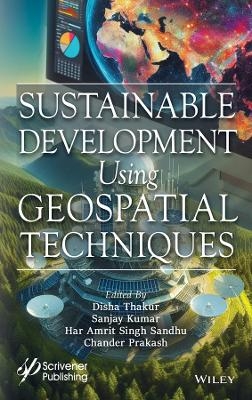
Sustainable Development Using Geospatial Techniques
Wiley-Scrivener (Verlag)
978-1-394-21434-1 (ISBN)
Geospatial technology (GT) is a combination of geographic information systems (GIS), remote sensing (RS), and the global position system (GPS) for the mapping, visualization, and analysis of natural resource planning. Nowadays, GIS is widely used throughout the globe for a wide range of applications. GIS is a system that combines locations, geography, hardware, software, statistics, planning, and digital mapping. GIS is a system in which one can store, manipulate, analyze, and visualize or display spatial data. The basic components of GIS are hardware, software, data, input, and manpower. One can develop spatial, temporal, and dynamic models using GIS, which may help in effective decision-making tools.
Geospatial information is a computer programme that collects, stores, verifies, and presents information on locations on the surface of the Earth. Geographical information systems play a key role in sustainable development. Geospatial technology combines traditional database operations like query and statistical analysis with the specific graphical and geographic analytical capabilities offered by maps.
Disha Thakur, PhD is an assistant professor in civil engineering at the University Institute of Technology (UIT), Shimla, India. She has published 13 research and conference papers and book chapters in reputed journals and national and international Conferences. Her research interests include geotechnical engineering and solid waste management. Sanjay Kumar, PhD is working an assistant professor at the University Institute of Technology, Himachal Pradesh University, Shimla, India. He has research experience in various areas of electrical engineering. He has published 24 research papers in reputed national and international journals and 18 research papers in national and international conferences. He has 8 years of teaching and has delivered expert lectures at many colleges and universities in India. Har Amrit Singh Sandhu, PhD is part of the faculty in the Civil Engineering Department at Punjab Engineering College, Chandigarh, India. He is also president of the American Society of Civil Engineers’ Indian Chapter (North) and the coordinator at the Centre of Geospatial Technologies and a Digital India Land Records Modernization Programme cell. He has more than 20 years of experience in working, teaching, and researching in the geospatial field and has published various research papers in reputed national and international journals. Chander Prakash, PhD is an assistant professor in the Civil Engineering Department at the National Institute of Technology (NIT), Hamirpur, India. He has published more than 25 research papers in reputed national and international journals and conferences and has completed a number of research and development projects.
Preface xvii 1 Development of a Two-Layer Meta-Classifier–Based Drought Stress Detection System for Wheat Crop Sustainability 1
Ankita Gupta, Lakhwinder Kaur and Gurmeet Kaur
2 Comparison of Geo-Statistical Techniques: A Study Based on Mapping Soil Properties for a Lower Himalayan Watershed 41
Sahil Sharma, Shankar Yadav, Vinay Meena and Deepak Swami
3 Monitoring Crop Conditions of Punjab State Using Big Data Analytics 59
Harpinder Singh, Ajay Roy, Shashikant Patel and Brijendra Pateriya
4 An Investigation into Use of Ethereum Blockchain Technology to Validate the Reliability and Quality of Stored Satellite Images 73
Lince Mathew, Hamid Jahankhan and Sumesh Dadwal
5 Urban Expansion and Traffic Congestion: A Geographical Study of Shimla 107
Akshat Sharma and Amardeep Boora
6 Landslide Susceptibility Analysis for Sustainable Development in the Indian Himalayas 129
Ankur Sharma and Har Amrit Singh Sandhu
7 Application of Geospatial Tools in Glacial Lake Outburst Floods: Mapping and Monitoring 155
Anita Sharma, Vansheika and Chander Prakash
8 Dynamic Coastal Flood Risk Assessment of a Coastal Island in West Bengal, India 181
Praneta, N., Aishwarya, N. and Bharath, H. A.
9 A Review of Methods for Studying Glacier Dynamics Due to Climate Change in the Himalayas 217
Shanta Kumar and Anurag Linda
10 Geospatial Techniques for Flash Flood Hazard Assessment and Management 241
Nitesh Godara, Amit Challana, Tarun Bansal and Arun Bawa
11 Prediction of Water Hardness Using Machine Learning and Model Interpretation 263
Aarti Kochhar, Harpinder Singh, Shashikant Patel, P.K. Litoria and Brijendra Pateriya
12 Air Quality Mapping Using GIS for Kanpur City, India 285
Varun Yadav and Rajiv Ganguly
13 Geospatial Modeling Approach and Characteristics Study of Graphene-Anchored Cu-Nanoferrites and Their Potential in Arsenic Containing Wastewater Treatment 299
G. Murtaza and Ahmad Ayyaz
14 Managing Construction and Demolition Waste Illegal Dumping through GIS: A Case Study of Urban Metropolitan 327
Shubhi Nuna, Bharath H. Aithal and Brajesh Dubey
15 Assessment of Human Health Risk in Baitarani Basin, Odisha Using Water Quality Index (WQI), Cluster Analysis (CA), and Geographic Information Systems (GIS) 365
Abhijeet Das
16 Drone Mapping for Agricultural Sustainability: Applications and Benefits 411
Arun Bawa, Gurjinder Baath, Pulkit Juneja and Jaiveer Brar
17 Advanced Use of Drones in Irrigation and Water Management 437
Swati Sharma and Pragya Singh
Index 455
| Erscheinungsdatum | 12.10.2024 |
|---|---|
| Sprache | englisch |
| Themenwelt | Naturwissenschaften ► Biologie ► Ökologie / Naturschutz |
| Naturwissenschaften ► Geowissenschaften ► Geologie | |
| ISBN-10 | 1-394-21434-0 / 1394214340 |
| ISBN-13 | 978-1-394-21434-1 / 9781394214341 |
| Zustand | Neuware |
| Haben Sie eine Frage zum Produkt? |
aus dem Bereich


